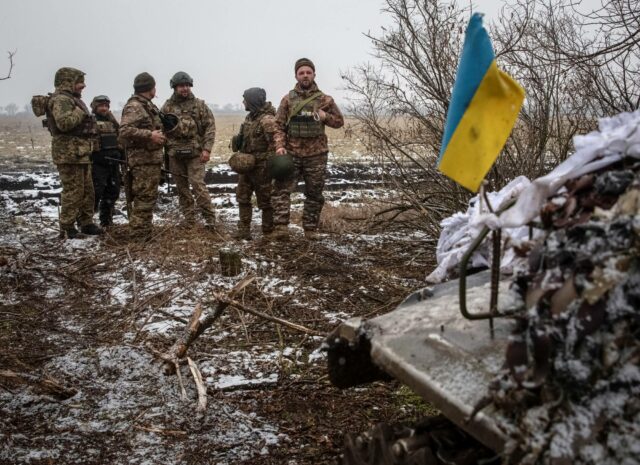
Moving the Goalposts: Russia’s Evolving War Aims in Ukraine (Part Two)
Publication: Eurasia Daily Monitor Volume: 20 Issue: 42
By:

*Read Part One.
Russia’s war aims in Ukraine fall into two main categories: pre-programmed goals, which were announced from the start of the war (still being paid some lip service to date), and opportunity goals, which the Kremlin might have anticipated when planning the war but which crystallized gradually as the war unfolded (see EDM, March 9).
The former, maximalist set of war aims has been designed to deprive Ukraine of its national identity and viable statehood. The latter, more narrowly focused aims are intended to extinguish Ukrainian identity in the Russian-occupied territories and render Ukrainian statehood nonviable in the remaining free territory.
Ukraine’s desperate defense has compelled Russia to downplay or downscale the initial, maximalist objectives at least temporarily, so as to lure Kyiv and its Western partners into negotiating from positions of weakness on the battlefield. Meanwhile, Russia focuses on opportunity goals to devastate Ukraine’s economy and demography by resorting to various horizontal forms of escalation.
Moscow’s initial aims, seemingly or temporarily downscaled since then, relate to:
(1) Regime Change in Kyiv—The Kremlin failed at the outset of the war to take Kyiv and overthrow, force into flight or otherwise eliminate the Ukrainian state leadership. Moscow left no doubt as to its aim to remove President Volodymyr Zelenskyy and his government from power, but it never came up with a substitute team to take over in 2022 or since then. The moment the blitzkrieg operation failed to overthrow Zekenskyy’s government, Moscow accepted the possibility of holding negotiations with it (see below), albeit strictly on Russian terms, which could have fractured Zelenskyy’s broad base of support and destabilized the government.
Zelenskyy’s circle assumes in retrospect that Moscow planned to administer Ukraine through local Russophile politicians with their narrow political base among pro-Russian voters. This illusory “second Ukraine” is a selling point of Ukrainian Russophile politicians, such as Viktor Medvedchuk pitching their political projects to the Kremlin (Dzerkalo Tyzhnia, March 7). Moscow’s spokesman Dmitry Peskov most recently confirmed the regime-change goal, its temporary deferral, as well as the dearth of credible collaborators: “After completing the special military operation, we shall work with those political groups in Ukraine that dislike the present regime. Even if these groups are not as large as we might like. Some groups are in Ukraine, but they must keep their heads down, and some are in Russia” (Izvestiya, February 28).
(2) “Denazification” of Ukraine—Inasmuch as Moscow has depicted the Ukrainian state leadership and mainstream Ukrainian patriotism as Nazi, neo-Nazi, fascist and simply nationalist (Moscow uses these terms interchangeably), denazification would imply: regime change; purging state institutions; banning patriotic political parties and civic associations (as “Nazi/nationalist”); rolling back cultural Ukrainization in favor of a re-Russification policy, including in the area of historical memory; censoring Ukrainian mass media; and plugging Ukraine back into Russia’s state media space. Russia’s policies in the occupied territories (see EDM, October 12, 13, 27, 2022 Part One and Part Two) are harbingers of what would befall other parts of Ukraine if occupied as well.
(3) “Demilitarization” of Ukraine—The Kremlin defines this goal on multiple levels: first, banning any weapons systems from Ukraine’s postwar territory that Russia would regard as potentially threatening to itself; second, reducing the Ukrainian Armed Forces and their equipment to levels that would leave Ukraine exposed to the threat of repeated Russian invasions; third, ruling out any foreign (in this case, Western) military presence in Ukraine; fourth and overarching, opting for Ukrainian neutrality and nonalignment (Moscow uses both terms in this combination with regard to Ukraine), albeit inadequately armed, unlike the armed model of neutrality or nonalignment.
Meanwhile, Ukraine’s postwar boundaries will probably reflect the frontlines if and when an armistice is concluded. Russian President Vladimir Putin (TASS, February 21) and other civilian and military officials take the position that Russian territory (including the Russian-occupied Ukrainian territories) must be out of reach to any long-range missiles that Ukraine might deploy on Ukrainian-controlled territory. The Kremlin therefore explicitly reserves the right to push the frontline (assuming that it can) further inside Ukraine in correlation with the range of missiles that Ukraine might yet receive from its Western partners.
Russia thereby requires Ukraine to desist from its aim (though enshrined in the Ukrainian Constitution) of joining the North Atlantic Treaty Organization (NATO) and to renounce any form of Western security guarantees even if these operated outside the NATO framework. Ukraine, however, seeks both a fast track to NATO membership and an interim format of Western non-NATO security guarantees through the Kyiv Security Compact (see EDM, December 16, 2022). Both the fast track and the interim compact are meant to come into effect in the post-conflict period, which is why Moscow wants to ensure that no clear-cut post-conflict period actually begins. The Kremlin takes the position that any international security guarantees for Ukraine must include Russia among the co-guarantors, so as to paralyze this mechanism. The compact, on the other hand, would be confined to Western powers, excluding Russia not only from this mechanism but potentially also from the European concert of powers, wherein the compact’s greatest value resides.



